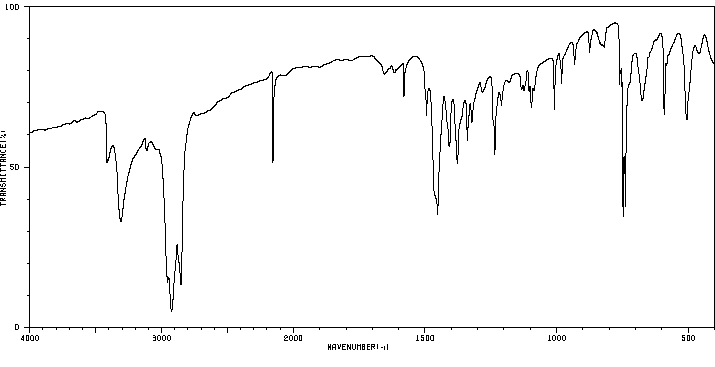3-selenocyanate-1H-indole | 21856-92-8
中文名称
——
中文别名
——
英文名称
3-selenocyanate-1H-indole
英文别名
3-selenocyanato-1H-indole;3-selenylcyano-1H-indole;3-(selenocyanato)indole;3-indole selenocyanate;3-selenocyanatoindole;3-selenocyanato-indole;1H-indol-3-yl selenocyanate
CAS
21856-92-8
化学式
C9H6N2Se
mdl
——
分子量
221.12
InChiKey
NEPIUULRQYXNOA-UHFFFAOYSA-N
BEILSTEIN
——
EINECS
——
-
物化性质
-
计算性质
-
ADMET
-
安全信息
-
SDS
-
制备方法与用途
-
上下游信息
-
文献信息
-
表征谱图
-
同类化合物
-
相关功能分类
-
相关结构分类
计算性质
-
辛醇/水分配系数(LogP):0.98
-
重原子数:12
-
可旋转键数:1
-
环数:2.0
-
sp3杂化的碳原子比例:0.0
-
拓扑面积:39.6
-
氢给体数:1
-
氢受体数:1
上下游信息
反应信息
-
作为反应物:描述:3-selenocyanate-1H-indole 在 sodium tetrahydroborate 、 sodium 作用下, 以 乙醇 为溶剂, 反应 1.5h, 生成 5-[(1H-indol-3-yl)selanyl]-2-nitroaniline参考文献:名称:Synthesis and evaluation of benzimidazole carbamates bearing indole moieties for antiproliferative and antitubulin activities摘要:A series of novel benzimidazole carbamates bearing indole moieties with sulphur or selenium atoms connecting the aromatic rings were synthesised and evaluated for their antiproliferative activities against three human cancer cell lines (SGC-7901. A-549 and HT-1080) using an MTT assay. Compounds 10a, 10b, 7a, 7b and 7f showed significant activities against these cell lines. The most potent compound in this series, 10a, was selected to investigate its antitumour mechanism. In addition, molecular docking studies suggested that compound 10a interacts very closely with the nocodazole docking pose through hydrogen bonds at the colchicine binding site of tubulin. (C) 2014 Elsevier Masson SAS. All rights reserved.DOI:10.1016/j.ejmech.2014.09.071
-
作为产物:描述:参考文献:名称:3-Selenocyanate-indoles as new agents for the treatment of superficial and mucocutaneous infections摘要:对现有抗真菌剂产生抗药性是一个令人担忧的问题。DOI:10.1039/c8nj04935a
文献信息
-
Oxidative umpolung selenocyanation of ketones and arenes: An efficient protocol to the synthesis of selenocyanates作者:Jianguo Cui、Meizhen Wei、Liping Pang、JunAn Xiao、Chunfang Gan、Jiali Guo、Chuanfang Xie、Qiming Zhu、Yanmin HuangDOI:10.1016/j.tet.2020.130978日期:2020.3A practical method for the umpolung selenocyanation of aryl ketones, alkyl ketones, β-ketoesters and electron-rich arenes has been developed, affording various selenocyanates in moderate to excellent yields. This transformation proceeds by an oxidative umpolung selenocyanation through nitrogen oxides-mediated electrophilic selenocyanation process. This method is simpler, more efficient, and less costly
-
N-Selenocyanato-Dibenzenesulfonimide: A New Electrophilic Selenocyanation Reagent作者:Zhi-Min Chen、Deng Zhu、Ai-Hui YeDOI:10.1055/a-1493-6885日期:2021.10A new electrophilic selenocyanation reagent N-selenocyanato-dibenzenesulfonimide was readily prepared in two steps from commercially available dibenzenesulfonimide for the first time. A variety of electrophilic selenocyanato reactions of nucleophiles have been achieved using it as selenocyanato source under mild and simple conditions. Numerous SeCN-containing compounds were obtained in moderate to
-
A low-cost electrochemical thio- and selenocyanation strategy for electron-rich arenes under catalyst- and oxidant-free conditions作者:Xing Zhang、Chenguang Wang、Hong Jiang、Linhao SunDOI:10.1039/c8ra04407d日期:——
A low-cost and efficient thio- and selenocyanation strategy for electron-rich arenes has been developed under constant-current electrolytic conditions in an undivided cell without the use of any catalyst or oxidant.
-
Facile, regioselective oxidative selenocyanation of <i>N</i>-aryl enaminones under transition-metal-free conditions
-
一种3-硒氰基吲哚化合物的合成方法
表征谱图
-
氢谱1HNMR
-
质谱MS
-
碳谱13CNMR
-
红外IR
-
拉曼Raman
-
峰位数据
-
峰位匹配
-
表征信息
同类化合物
(Z)-3-[[[2,4-二甲基-3-(乙氧羰基)吡咯-5-基]亚甲基]吲哚-2--2-
(S)-(-)-5'-苄氧基苯基卡维地洛
(R)-(+)-5'-苄氧基卡维地洛
(R)-卡洛芬
(N-(Boc)-2-吲哚基)二甲基硅烷醇钠
(E)-2-氰基-3-(5-(2-辛基-7-(4-(对甲苯基)-1,2,3,3a,4,8b-六氢环戊[b]吲哚-7-基)-2H-苯并[d][1,2,3]三唑-4-基)噻吩-2-基)丙烯酸
(4aS,9bR)-6-溴-2,3,4,4a,5,9b-六氢-1H-吡啶并[4,3-B]吲哚
(3Z)-3-(1H-咪唑-5-基亚甲基)-5-甲氧基-1H-吲哚-2-酮
(3Z)-3-[[[4-(二甲基氨基)苯基]亚甲基]-1H-吲哚-2-酮
(3R)-(-)-3-(1-甲基吲哚-3-基)丁酸甲酯
(3-氯-4,5-二氢-1,2-恶唑-5-基)(1,3-二氧代-1,3-二氢-2H-异吲哚-2-基)乙酸
齐多美辛
鸭脚树叶碱
鸭脚木碱,鸡骨常山碱
鲜麦得新糖
高氯酸1,1’-二(十六烷基)-3,3,3’,3’-四甲基吲哚碳菁
马鲁司特
马鞭草(VERBENAOFFICINALIS)提取物
马来酸阿洛司琼
马来酸替加色罗
顺式-ent-他达拉非
顺式-1,3,4,4a,5,9b-六氢-2H-吡啶并[4,3-b]吲哚-2-甲酸乙酯
顺式-(+-)-3,4-二氢-8-氯-4'-甲基-4-(甲基氨基)-螺(苯并(cd)吲哚-5(1H),2'(5'H)-呋喃)-5'-酮
靛青二磺酸二钾盐
靛藍四磺酸
靛红联二甲酚
靛红磺酸钠
靛红磺酸
靛红乙烯硫代缩酮
靛红-7-甲酸甲酯
靛红-5-磺酸钠
靛红-5-磺酸
靛红-5-硫酸钠盐二水
靛红-5-甲酸甲酯
靛红
靛玉红衍生物E804
靛玉红3'-单肟5-磺酸
靛玉红-3'-单肟
靛玉红
靛噻
青色素3联己酸染料,钾盐
雷马曲班
雷莫司琼杂质13
雷莫司琼杂质12
雷莫司琼杂质
雷替尼卜定
雄甾-1,4-二烯-3,17-二酮
阿霉素的代谢产物盐酸盐
阿贝卡尔
阿西美辛杂质3







